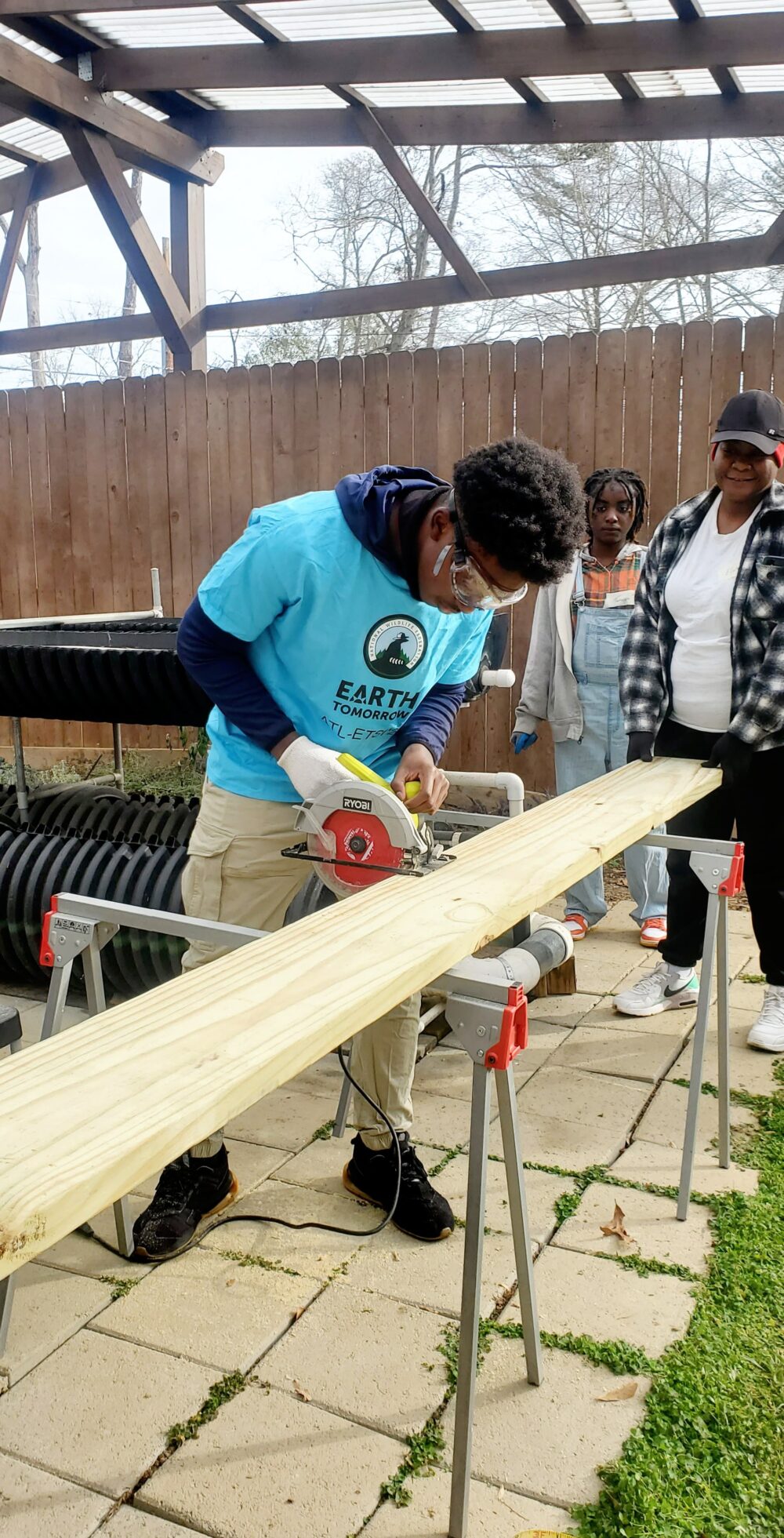We have much more to do and your continued support is needed now more than ever.
Green Jerseys: Sustainability on the Field
NWF
August 25, 2009

The University of Colorado at Boulder has committed to “zero waste” in its Folsom Stadium for all home football games. The University of Florida at Gainesville just completed its new LEED Platinum football stadium and has plans to purchase carbon offsets to minimize the impact of football games. The University of Maryland at College Park has put into place an aggressive recycling program whose biggest impact will likely be at pre-game tailgates. University of Notre Dame has committed to one carbon neutral football game a year, and is using television coverage to publicize a challenge to get players to commit to more sustainable lifestyles. And other initiatives are taking place at Wisconsin-Madison, Florida State, Georgia and Tennessee-Knoxville.
“Athletics is the center of our college community. It’s where everyone comes together, and stakeholders and campus constituents are all there,” says Dave Newport, director of CU-Boulder’s environmental center. “It’s a very good place to promote this activity and be able to reach the entire campus in one place … It’s about proving to them it’s possible and taking on the biggest trash nightmare possible.”
This green football trend that has developed over the last few years comes at the same time as a report released in July 2009 saying that campus athletic programs are behind the curve when it comes to sustainability practices. The study, which compared the importance placed on sustainability in athletics to the importance placed on sustainable campuses as whole, found a big disparity, showing that very few big football schools were taking sustainability in athletics as seriously as they should be. But with new initiatives popping up all over the place, college athletics may finally be getting the boost that many say can’t come fast enough.
Making the Changes
At CU-Boulder, Newport brought together multiple university departments to change the way waste items from food and retail were handled by putting into place recycling and compost bins, and removing public trash cans. This also involved replacing regular plastic utensils and food items with recyclable materials. The effort was supported by a host of students and staff who made sure all waste was disposed of in the appropriate way. The total cost of the initiative in its first year came to $20,000, about half of which, Newport says, went to start-up costs.
Having finished one football season with the “Green Stampede” program, the university has touted a recycle rate of 80 percent. Altogether, the waste produced from Colorado’s sports program counts for about 10 percent of the university’s total waste. And the carbon footprint produced by Colorado’s waste is less than 1 percent of the university’s total carbon footprint. Newport noted that when upstream and downstream waste impacts are taken into account, waste makes up about 10 percent the school’s carbon impact, but acknowledged that the current methodologies for computing carbon impact are flawed.
The total carbon impact of the zero waste program may only be a baby step in the broader goal of achieving carbon neutrality, but the next stage seems to be expanding the initiatives to the rest of the university. Now, the CU-Boulder is planning to implement the “zero waste” initiative at other campus athletics. Eventually, Newport wants the entire campus to become waste free, but acknowledged that purging a large open campus of trash would be substantially more difficult.
“The football stadium is a microcosm of a society. You change the supply chain, secure the perimeter, and then you can deal with it. It’s harder to do it campus-wide because you can’t secure the perimeter,” Newport says, noting that without monitoring who comes and leaves the campus it’s harder to keep trash out.
Notre Dame is by all means a football school. During home games, the university’s small college town sees an influx of fans, with about 100,000 people packing the stadium. According to Pat O’Hara, who works in operations at Notre Dame, the university closely tracks levels of waste, and sees a blip on the charts every home football game. Thus, tackling the sustainability obstacles of game day was a logical place to start.
In 2007 the university put into effect recycling initiatives, which led to the diversion of 73 tons of waste during the last football season. Game day recycling and other waste reduction programs on campus helped the university to recycle nearly 40 percent of its post-consumer waste during the 2008-2009 fiscal year, according to university data. Furthermore, the university designated one home game last year a “carbon neutral” game, and sought to offset its carbon impact through energy conservation projects led by students. Such projects included the installation of compact fluorescent lamps, game day recycling, and minimization of energy in residence halls. This went along with a challenge sponsored by NBC, the network televising the game, to see which team had more players willing to commit to leading greener lives.
The University of Florida — another football-centric school — just completed its new football complex this spring, and with it came a LEED Platinum rating. The building, an addition to the existing Griffin Stadium, is the first athletic facility in the nation and first building in the state of Florida to get such a rating. In 2007, Florida also began a program to offset the carbon dioxide produced during one of its games by planting enough trees to absorb the carbon created.
Maryland worked to cut down on tailgating waste with its “feed the turtle” initiative, a play on its athletics motto, “fear the turtle.” Recycling was aggressively encouraged during tailgating, and for the high donor parking lot, students went around from person to person collecting recycling in a program called “valet recycling,” according to Scott Lupin, associate director of environmental safety at Maryland.
Lupin and Newport say they often get calls from other schools asking them how they can implement similar ideas in their own football programs, indicating that this is a trend apt to spread even further.
Acting as a Cheerleader
Due to the extensive resources needed to put on a football game, truly mitigating the environmental impact of a tailgate-laden football season is nearly impossible — and initiatives here or there may not make a large long-term difference to the atmosphere. But one of the biggest values of the initiatives may be adding a bit of team spirit to sustainability practices. That these programs may be most productive in getting students, faculty, staff and alumni excited about being green puts the programs in a “cheerleading” role on the sidelines of the green movement.
According to O’Hara, one of the biggest impacts of the Notre Dame initiatives is raising awareness. “The number of people it touches when they visit campus, and when they go away and tell others, it has a cascading effect. We get a lot of feedback from our alumni base and visitors to campus; people are looking for [the green initiatives] when they visit.”
Jennifer Andrews is the campus program manager for Clean Air Cool Planet, an organization that works on global warming solutions and created the Campus Carbon Calculator, a means of measuring carbon emissions. She agreed that while these green football initiatives definitely have quantifiable results, the popularity of football gives them more of an edge in making sustainability prominent.
“I think they can make a substantial impact on cutting down on waste, and in terms of creating a culture of conservation on campus and educating sports fans. To a great degree the impact of carbon neutral or recycling sports events are in the latter category,” she says. “A game may or may not ever be able to be carbon neutral. But with what goes into a sporting event, it has an opportunity to reach out to an audience.”
Andrews noted that sometimes green initiatives can be “greenwashed” to the extent that there is more marketing about the initiative than there is actual change taking place. However, a heavy focus on promotion of sustainability is not necessarily a bad thing, she said, if it gets people excited about going green.
“Sometimes there is more rhetoric than substance to some of these measures, and where that’s the case there’s room for improvement,” she said. “That said, my personal sense is the more you get the word out about the value of ‘going green’ or ‘zero waste’ or whatever the motto is, the more you have a chance to push that into popular culture, and the better off we are in the long run.”
Another clue to the “popularity” aspect of these sustainability initiatives is the timeliness with which many of them were implemented — many schools unveiled their football sustainability initiatives during their biggest campus rivalries of the year. Notre Dame planned its “carbon neutral” game to coincide with its match-up against long time rival Syracuse University. The NBC-sponsored challenge of getting the most possible football players to commit to sustainable lifestyles pitted the two schools against each other for a $10,000 prize for the winning university. Florida unveiled its carbon offsetting program for its game against next-door rival Florida State University. The University of Georgia generated all of its energy from renewable sources for its game against Georgia Tech last year, and Wisconsin had its first “carbon neutral” game during its homecoming match-up against Big Ten companion the University of Illinois.
Bucking the Trend in College Athletics
While green football programs might be going full steam ahead, they appear to contradict data found in a study released last month by the Association for the Advancement of Sustainability in Higher Education. Report author Mark McSherry got 97 responses from a survey he sent to the 119 schools in the Football Bowl Subdivision of the National Collegiate Athletics Association, which includes many of the schools with large, highly publicized football teams.
The surveys, which were filled out by officials in the athletics departments of these schools, showed that while over 72 percent of respondents thought their university placed sustainability as a high or very high priority, just over 44 percent of athletics departments placed green practices as a high or very high priority. Furthermore, less than 10 percent of athletics departments had any formalized strategic sustainability plans. Over half of respondents said that while they had some sustainability initiatives for their athletics programs, they had no strategic plan whatsoever. Just over 25 percent said that the NCAA was supportive of university sustainability efforts. Officials at the NCAA did not return a call for comment.
McSherry says that the data seem to show disconnect between different departments of the universities. He pointed to one finding of his survey showing that although 50 percent of the schools had signed the U.S. University and College President’s Climate Action Commitment, nearly 80 percent of respondents said that they did not know whether their president had signed it or not. Though the university as a whole may be focusing on sustainability, that information hadn’t spread to the athletics department.
Newport suggests that the sluggish rate at which athletics departments are latching onto sustainability could be due to the fact all of the different departments in a university are often in competition with each other. In a world of limited resources, athletics departments may just be losing out in attempts to gain attention and consultation about green practices.
“There are a lot of other folks fighting for air time. Everyone wants to support athletics, but Monday through Friday we’re doing something else, there’s a lot of other stuff to do,” Newport says.
Lupin asserts that because athletics departments are often self-supporting entities in a university, they might have different priorities dictated by the fact that they need to generate revenue. With the current state of the economy, declining ticket sales and revenue may mean fewer resources to jump on the sustainability bandwagon.
“Their culture and outlook is a little different than other campus departments,” Lupin says. “I think they are very interested to the extent they can be. It comes down to the leadership of the department — if the senior leadership is interested, they will become engaged.”
McSherry adds that although athletics departments may be behind in green practices, they are going to catch up very quickly. “It’s inevitable — it’s going to happen. We’re at the tip of the trend, and there is going to be more emphasis on the environmental issues,” he said. And green football initiatives might just be the beginning of it.
Playing Catch-Up
Just as many athletes have their sights set on the pros, college athletic departments have the National Football League to look to as inspiration for their green initiatives. The NFL first implemented a recycling program for the Super Bowl 17 years ago, and has continued to expand on its green practices since then. Today, the Super Bowl invests in a number of green initiatives, from solid waste disposal to food donation. In recent years, the Super Bowl has switched some of its fleet to hybrid vehicles, used biodiesel fuel around some of its stadiums, bought renewable wind and solar energy, purchased offsets for staff and player travel, and participated in forestry programs.
Jack Groh, the NFL’s director of environmental programs, says that one goal of the programs is to invest in sustainability with a business-conscious attitude. “We straddle the line between good environmental principal and good business model,” he said. “It doesn’t mean we don’t try to push the envelope a little bit. Our challenge becomes how do we maximize what we are doing in those instances?”
Because of this focus, the NFL has not gone out of its way to be visible about its green programs and get the word out about sustainability. However, individual NFL teams may be taking a more publicly-driven role in their own initiatives. Andrews, from Clean Air Cool Planet, is working with organizations in Pittsburgh that are partnering with the Pittsburgh Steelers on sustainability initiatives. She said that potential for the NFL to reach a large audience may be its greatest asset.
“Is the NFL the greenest organization? No. Will it ever be? Probably not in the short term. On the other hand, they have a huge audience and a lot of marketing leverage, so if they want to throw it behind the cause, [they can make a real difference],” says Andrews.
For those looking to expand their sustainable reach, Groh warns against over-investing in programs without doing one’s research. He said that too often organizations fall into traps like buying into scams for carbon offsets without knowing where the funds are really going. He emphasized that being practical about decision-making and doing one’s research will help make the largest difference.
“It is possible to say this trend of sustainability-focused sports has made a quantifiable difference,” Andrews says. “Is it enough? No, not enough, yet not be dismissed.”




















